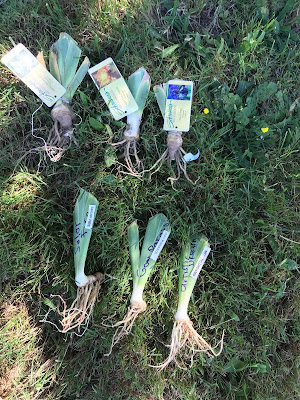 |
| New Bearded Iris Rhizomes. 7.21.19 |
 |
| Bearded Iris Garden. 7.21.19 |
 |
| Bearded Iris Garden. 7.21.19 |
I certainly don't need more varieties, but it's fun to test new ones. Those came in the mail two days ago. My mistake, two are duplicates of ones I thought were lost, but then found. So there are only four new ones. I planted the duplicates next to clumps of the same cultivars.
I discarded several big clumps of varieties I consider underwhelming, or have too many duplicates. I also moved some clumps to new raised beds in the old Vancouver yard. I also divided several clumps, and refreshed some overgrown clumps by removing the old dead rhizomes and too-small offshoots, keeping the vigorous young ones. In particular, I divided "Immortality" and wound up with 4 clumps, one of which went to Vancouver and one to an "overstock"bed, to give away if someone wants it. That bed also ot a big established clump of "Accent" as well as a smaller clump of "Sunny Disposition".
Some clumps were too close together. I had underestimated their vigor. I moved them further apart, so now the space that had 12 clumps, only has six, evenly spaced.
In the main iris bed, there are two very big clumps that did not bloom this Spring. I left them in place for one final chance next Spring. For all I know, they may be more uglies, or duplicates of others. Or they my be something nice.
From the "recovery" beds I discarded clumps of two ugly and one that was too many of that cultivar, and moved 3 clumps that I liked into the main iris garden.
 |
| Bearded Iris Garden. 7.21.19 |
As for cutting back the leaves, for the most part I did not. I was careful to avoid too much root trauma, so I didn't think that I needed to remove leaves to balance for root loss. Leaves mean photosynthesis, which sends sugars for storage to the rhizomes for strong growth and bloom next year. I am progressively cutting off all old leaves that look dry or very droopy.
Other than minor weeding, cultivating with stirrup hoe (shallow), and removing dead leaves, there isn't much more to do. I might water the new ones, and the reblooming varieties, once a week until fall. I'll cut back the leaves in late fall too.
































